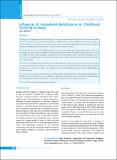Please use this identifier to cite or link to this item:
https://hdl.handle.net/20.500.14356/1156Full metadata record
| DC Field | Value | Language |
|---|---|---|
| dc.contributor.author | Bhattarai, Sanju | - |
| dc.date.accessioned | 2023-04-28T07:23:50Z | - |
| dc.date.available | 2023-04-28T07:23:50Z | - |
| dc.date.issued | 2021 | - |
| dc.identifier.citation | BhattaraiS. (2021). Influence of Household Remittance on Childhood Stunting in Nepal. Journal of Nepal Health Research Council, 19(03), 568-576. https://doi.org/10.33314/jnhrc.v19i3.2766 | en_US |
| dc.identifier.issn | Print ISSN: 1727-5482; Online ISSN: 1999-6217 | - |
| dc.identifier.uri | http://103.69.126.140:8080/handle/20.500.14356/1156 | - |
| dc.description | Original Article | en_US |
| dc.description.abstract | Abstract Background: Migration is a livelihood strategy for many poor households in Nepal. About 56% of the households receive remittances, the country also has high rates of undernutrition as 36% of children under five years of age are stunted. Remittance are known to increase household income, potentially contributing to improvements in health and nutrition of children, but few studies have examined it in the Nepalese context. Methods: We used data of 2,498 children under 5 years of age from the Nepal Living Standard Survey 2010/11 to investigate associations between childhood stunting and household remittances. Multiple logistic regression was used to evaluate the odds of child stunting by remittances received by the families in the 12 months preceding the survey. Guided by a conceptual framework, the model was adjusted for variables representing child, maternal and household level characteristics. Results: Our investigation showed that the odds of a child being stunted decreased with increased levels of remittance received by households, 67% (OR: 0.33, 95% CI: 0.16, 0.67) lower for households receiving more than Nrs.60,000 remittance per year. However, there was no difference in the risk of stunting by gender of the household head and income categories. Conclusions: An increased household income could potentially reduce the burden of chronic undernutrition in poor families in Nepal, which in turn paves a path for the expansion of cash transfer programs. Further research is indicated to understand the threshold of remittance or cash transfer needed to estimate nutritional outcomes. Keywords: Income; nutrition; remittance; stunting | en_US |
| dc.language.iso | en | en_US |
| dc.publisher | Nepal Health Research Council | en_US |
| dc.relation.ispartofseries | July-Sep, 2021;2766 | - |
| dc.subject | Income | en_US |
| dc.subject | nutrition | en_US |
| dc.subject | remittance | en_US |
| dc.subject | stunting | en_US |
| dc.title | Influence of Household Remittance on Childhood Stunting in Nepal | en_US |
| dc.type | Journal Article | en_US |
| local.journal.category | Original Article | - |
| Appears in Collections: | Vol. 19 No. 03 (2021): Vol 19 No 3 Issue 52 Jul-Sep 2021 | |
Files in This Item:
| File | Description | Size | Format | |
|---|---|---|---|---|
| 2766-Manuscript-25077-1-10-20211215.pdf | Fulltext Download | 254.65 kB | Adobe PDF |  View/Open |
Items in DSpace are protected by copyright, with all rights reserved, unless otherwise indicated.
